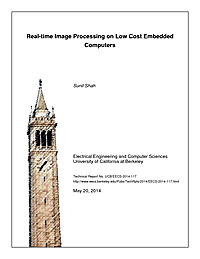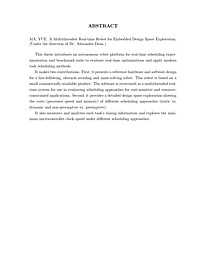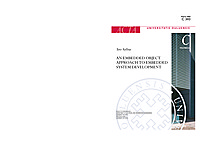
Real-time Image Processing on Low Cost Embedded Computers
In 2012 a federal mandate was imposed that required the FAA to integrate unmanned aerial systems (UAS) into the national airspace (NAS) by 2015 for civilian and commercial use. A significant driver for the increasing popularity of these systems is the rise in open hardware and open software solutions which allow hobbyists to build small UAS at low cost and without specialist equipment. This paper describes our work building, evaluating and improving performance of a vision-based system running on an embedded computer onboard such a small UAS. This system utilises open source software and open hardware to automatically land a multi-rotor UAS with high accuracy. Using parallel computing techniques, our final implementation runs at the maximum possible rate of 30 frames per second. This demonstrates a valid approach for implementing other real-time vision based systems onboard UAS using low power, small and economical embedded computers.

A Multithreaded Real-time Robot for Embedded Design Space Exploration
This thesis introduces an autonomous robot platform for real-time scheduling exper- imentation and benchmark suite to evaluate real-time optimizations and apply modern task scheduling methods. It makes two contributions. First, it presents a reference hardware and software design for a line-following, obstacle-avoiding and maze-solving robot. This robot is based on a small commercially-available product. The software is structured as a multithreaded real- time system for use in evaluating scheduling approaches for cost-sensitive and resource- constrained applications. Second, it provides a detailed design space exploration showing the costs (processor speed and memory) of di erent scheduling approaches (static vs. dynamic and non-preemptive vs. preemptive). It also measures and analyzes each task's timing information and explores the mini- mum microcontroller clock speed under di erent scheduling approaches.

An Embedded Object Approach to Embedded System Development
Building an embedded system from an idea to a product is a slow and expensive process requiring a lot of expertise. Depending on the developer’s expertise, the required quantity and price level of the final product, and the time and money available for development, the developer can build a device from different granularity of components, ranging from ready-made platforms, kits, and modules to individual components. Generally, solutions requiring less expertise, time and money produce products with higher production costs. The main contribution of this thesis is the EOC (Embedded Object Concept) and Atomi II Framework. EOC utilizes common object-oriented methods used in software by applying them to small electronic modules, which create complete functional entities. The conceptual idea of the embedded objects is implemented with the Atomi II framework, which contains several techniques for making the EOC a commercially feasible implementation. The EOC and the Atomi II Framework decreases the difficulty level of making embedded systems by enabling a use of ready-made modules to build systems. It enables automatic conversion of a device made from such modules into an integrated PCB, lowering production costs compared to other modular approaches. Furthermore, it also enables an automatic production tester generation due to its modularity. These properties lower the number of skills required for building an embedded system and quicken the path from an idea to a commercially applicable device. A developer can also build custom modules of his own if he possesses the required expertise. The test cases demonstrate the Atomi II Framework techniques in real world applications, and demonstrate the capabilities of Atomi objects. According to our test cases and estimations, an Atomi based device becomes approximately 10% more expensive than a device built from individual components, but saves up to 50% time, making it feasible to manufacture up to 10-50k quantities with this approach.

Real-time Image Processing on Low Cost Embedded Computers
In 2012 a federal mandate was imposed that required the FAA to integrate unmanned aerial systems (UAS) into the national airspace (NAS) by 2015 for civilian and commercial use. A significant driver for the increasing popularity of these systems is the rise in open hardware and open software solutions which allow hobbyists to build small UAS at low cost and without specialist equipment. This paper describes our work building, evaluating and improving performance of a vision-based system running on an embedded computer onboard such a small UAS. This system utilises open source software and open hardware to automatically land a multi-rotor UAS with high accuracy. Using parallel computing techniques, our final implementation runs at the maximum possible rate of 30 frames per second. This demonstrates a valid approach for implementing other real-time vision based systems onboard UAS using low power, small and economical embedded computers.

A Multithreaded Real-time Robot for Embedded Design Space Exploration
This thesis introduces an autonomous robot platform for real-time scheduling exper- imentation and benchmark suite to evaluate real-time optimizations and apply modern task scheduling methods. It makes two contributions. First, it presents a reference hardware and software design for a line-following, obstacle-avoiding and maze-solving robot. This robot is based on a small commercially-available product. The software is structured as a multithreaded real- time system for use in evaluating scheduling approaches for cost-sensitive and resource- constrained applications. Second, it provides a detailed design space exploration showing the costs (processor speed and memory) of di erent scheduling approaches (static vs. dynamic and non-preemptive vs. preemptive). It also measures and analyzes each task's timing information and explores the mini- mum microcontroller clock speed under di erent scheduling approaches.

An Embedded Object Approach to Embedded System Development
Building an embedded system from an idea to a product is a slow and expensive process requiring a lot of expertise. Depending on the developer’s expertise, the required quantity and price level of the final product, and the time and money available for development, the developer can build a device from different granularity of components, ranging from ready-made platforms, kits, and modules to individual components. Generally, solutions requiring less expertise, time and money produce products with higher production costs. The main contribution of this thesis is the EOC (Embedded Object Concept) and Atomi II Framework. EOC utilizes common object-oriented methods used in software by applying them to small electronic modules, which create complete functional entities. The conceptual idea of the embedded objects is implemented with the Atomi II framework, which contains several techniques for making the EOC a commercially feasible implementation. The EOC and the Atomi II Framework decreases the difficulty level of making embedded systems by enabling a use of ready-made modules to build systems. It enables automatic conversion of a device made from such modules into an integrated PCB, lowering production costs compared to other modular approaches. Furthermore, it also enables an automatic production tester generation due to its modularity. These properties lower the number of skills required for building an embedded system and quicken the path from an idea to a commercially applicable device. A developer can also build custom modules of his own if he possesses the required expertise. The test cases demonstrate the Atomi II Framework techniques in real world applications, and demonstrate the capabilities of Atomi objects. According to our test cases and estimations, an Atomi based device becomes approximately 10% more expensive than a device built from individual components, but saves up to 50% time, making it feasible to manufacture up to 10-50k quantities with this approach.



















